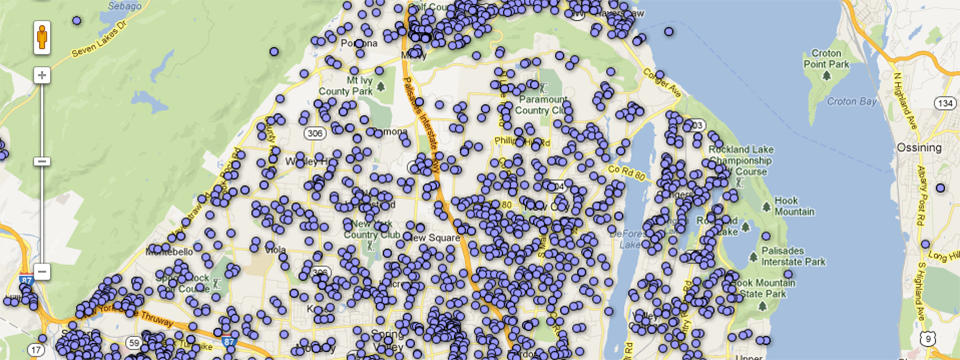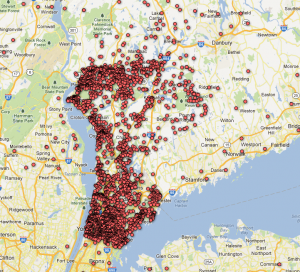
On Dec. 22 a local newspaper in New York published a map of registered gun owners. This data viz touched off quite a bit of controversy, followed by a lawyer publishing the home addresses of staffers, executives, the publisher, the editor and the reporter who wrote the story for The Journal News.
Suffice it to say, it’s become a major controversy sparking discussions on the availability of data, what is public versus what should be public information, and how media should decide what and how much to publish.
The primary issue in this case isn’t about data availability, whether that data should have been public or not (however these are good, important discussions to have.)
The issue here is the poor design and execution of this particular data viz project. When I say design, in this case I mean the design of the overall project.
The Journal News map didn’t need to be household specific. A heat map of the same data would have been informative enough for their purpose without making permit-holders feel targeted. Not to mention, the map only shows the addresses of people who have a permit, that doesn’t mean that they have a hand gun.
Normally, I don’t give much weight to the accusation that publishing public data is targeting anyone. However, this map was published shortly after a highly public, tragic and emotional event where guns were a significant and heated part of the following conversation.
Since the Journal News isn’t responding to anyone’s request for comments or interviews, there isn’t much to go on in terms of understanding how they arrived at the decision to publish the map as it was done besides the statement that “we felt sharing information about gun permits in our area was important in the aftermath of the Newtown shootings.”
Part of the problem with the map is that it fails the basic questions that should be asked before something like this is published.
If the purpose of the project was to inform people about the ownership of guns in their neighborhood, that could have still been accomplished without publishing the home addresses of gun owners.
In this case, the benefits to one party does not outweigh the considerations for those that are negatively affected.
In my experience, publishing public data can come with a lot of controversy when it deals with people’s identity being associated with the data. Sometimes that is appropriate and sometimes it is not.
When I worked for The Sun Star we created and published a database of all the University of Alaska’s employee salaries including the employee’s name. This was not without controversy, however it was the best mechanism for achieving the purpose of the database: accountability in spending, employee accountability, and data that could be used to identify inequalities and inefficiencies in the university.
When considering the database we had to consider what we were accomplishing, who we were affecting, what the possible side effects were.
In our case, all the employees are public employees and the information on their salaries is public information. I also had done research into other similar databases and in no cases ever found any examples of consequences that were damaging to any employees at those universities. That has held true for the Sun Star database as well.
Publishing large datasets, in any format, requires much more consideration than people want to know and because we can. And when things go wrong and the controversy gets this loud, it certainly requires more explanation and discussion than simply excusing it by saying sometimes journalists do controversial things in the name of the greater good. That argument helps no one.
Data journalism is a rapidly growing part of journalism and will be for some time. But we are also still at a point in time where many people don’t know or understand what that means for them and the publicly available information about them. This requires some diplomacy and explanation for data driven projects especially when identity is part of the published product. Be open about what you are doing and trying to accomplish before, during and after a project.
Taking data journalism a step further into data visualization adds further responsibility on the news organization. Anyone with an address and the internet can make a Google map, but journalists have a responsibility of making sure that the map created is appropriate and truly serves the greater good.

